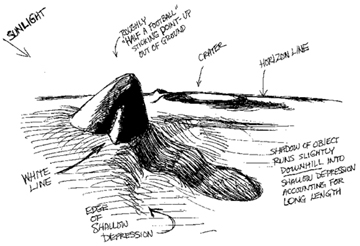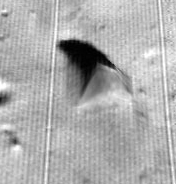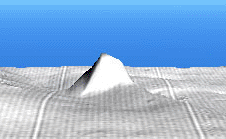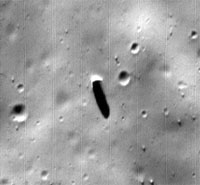Palermo's Phobos Anomalies

Image drawn by Andy Romano.
My interpretation of this structure on Phobos is that it is a building shaped artifact casting a long shadow from a relatively high sun angle, if it was a low sun angle, then any medium sized protrusion would cast a long shadow that's not proportionate to it's height. Lan Fleming did an extensive study of the sun and shadows on the web site pages he devoted to this Phobos Monolith. There have been other interpretations, most notably that it is an angular shaped rock placed in such a way that it casts a long shadow. In the image above drawn by Andy Romano and sent to me in November 2000, he theorized a pyramid shaped rock whose shadow dipped into a depression and thereby elongating it's shadow.
Recently Christopher A. Joseph rendered a 3D image of the 'Monolith' in Bryce and also came up with a pyramid shape. (See images to the right. Chris also created left and right 3D images, click here to go to that page).
These are very plausible explanations. A pyramid on Phobos would be as anomalous as a tall monolith. Mac Tonnies in his Cydonia Imperative, also pointed out that this could not be a remnant of the Stickney Crater impact as such a large mass would have escaped Phobos feeble gravity. There is no weather on Phobos so this could not be caused by erosion factors.


Page 2 - A Physical Mock-Up of the Monolith
Page 4 - Other Phobos Anomalies
Page 5 - Phobos Vital Statistics
Page 6 - Phobos Lore: Theories and Speculations
Page 7 - Phobos: Images of the Moon
Page 8 - Phobos Links
